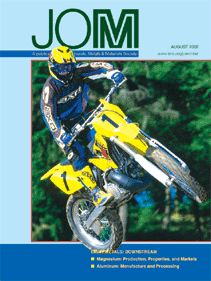VISIT THE
JOM COVER GALLERY
JOM
HOME PAGE
TABLES
OF CONTENTS
HTML-ENHANCED
ARTICLES
MATERIAL
MATTERS
CONSULTANTS
DIRECTORY
PROFESSIONAL PREFACE
SUBJECT
INDEXES
MEETINGS
CALENDAR
TECHNICAL
EMPHASIS CALENDAR
AUTHOR'S
KIT
AUTHOR
BIOGRAPHY/ABSTRACT SUBMISSION FORM
BOOK
REVIEW PROGRAM
ADVERTISING
INFORMATION
RESERVE
A CLASSIFIED
SUBSCRIPTIONS
SINGLE
ISSUE PURCHASES
|
|
The Doctrine of Equivalents Lives—U.S. Supreme Court
Reverses Federal Court
Arnold B. Silverman
In a major decision that will have far-reaching impact on issues
of infringement of U.S. patents, the U.S. Supreme Court, in overruling
the U.S. Court of Appeals for the Federal Circuit in the Festo case,
ruled that the doctrine of equivalents should be applied in a flexible
manner. This strengthens the patent owner’s position. The appellate
court ruled that any narrowing of a recital of a claim element absolutely
barred use of the doctrine of equivalents as to that element.
A U.S. patent contains one or more patent claims that define the
scope of the property provided by the claim. There are two ways in
which one can directly infringe a claim. First, if one satisfies
every recital of the claim, such infringement is termed “literal
infringement”. Second, under the judicially created doctrine
of equivalents, if one makes a minor departure from the claim and,
therefore, does not literally infringe, one may nevertheless be held
to be an infringer if one achieves substantially the same function
in substantially the same way to obtain substantially the same result.
This results from an equitable balancing of interests, leading to
the conclusion that one who makes an insubstantial change should not
be permitted to obtain the benefit of the invention while avoiding
infringement.
One manner in which the applicability of the doctrine of equivalents
is restricted or eliminated occurs when an original claim is narrowed
by amendment during prosecution to avoid prior art. The general concept
is that one who has surrendered coverage has made a deal with the
Patent and Trademark Office to obtain a patent and cannot later recapture
that surrendered coverage under the doctrine of equivalents.
A patent application is required by Section 112 of the statute to
have claims that particularly point out and distinctly claim the subject
matter of the invention. Under the Festo case, the Supreme Court made
it clear that a response to a rejection, based upon indefiniteness
in the context of such Section 112 requirements, may lead to a narrowing
of the claim to satisfy Section 112 and thereby also restrict the
availability of the doctrine of equivalents. The focus is whether
the amendments were made for a substantial reason related to patentability.
Such changes made during the prosecution of the application are generally
referred to as involving prosecution history estoppel.
In the Festo case the patent examiner entered a rejection under Section
112. The applicants added limitations to the claims. Subsequently,
the alleged infringer made a similar device. The Supreme Court remanded
the case to the Circuit to determine whether prosecution history estoppel,
through the amendments made by Festo, precluded its asserting the
doctrine of equivalents as a basis for alleging that the third party’s
device infringed.
Under the Federal Court opinion, which was reversed by a unanimous
Supreme Court, the rigid bar would have stated that, as two elements
in question were the subject of narrowing amendments, the doctrine
of equivalents could not be employed and, therefore, there would be
no infringement. Under the U.S. Supreme Court’s ruling that the
standard should be as it had been previously, a flexible bar, the
court stated that the coverage surrendered by the narrowing amendment
could not be recaptured, but there could be remaining equivalents
as to the narrowed language. The burden is on Festo, under the flexible bar standard considering the purpose of the amendments, to
prove that it retained sufficient equivalents to embrace the third-party
product. Part of what is considered in evaluating this issue is that,
at the time of drafting the narrowed limitation, one could not anticipate
creating such precise language in the description that no one could
devise an equivalent. Further, there is no reason why even a precisely
worded narrowing amendment should be deemed to relinquish equivalents
which were unforeseeable at the time of the amendment and were beyond
any reasonable interpretation of what was surrendered in narrowing
the claim.
The Supreme Court also went on to note that, under law prior to the
Court of Appeals’ ruling in the Festo case, the settled law involved
the flexible bar in applying the doctrine of equivalents. The court
conceded that a bright-line rule could not be adopted. On the other
hand, as to the large number of patents that were prosecuted under
the prior law, with the understanding that a flexible bar rule would
apply to the doctrine of equivalents, many applicants would have prosecuted
their applications differently had they understood that a rigid bar
precluding any application of the doctrine of equivalents as to an
amended element were to be employed. For example, rather than amending
a claim to narrow the claim, the applicant had the right to appeal
the rejection.
This clearly strengthens the position of the patent owner and creates
greater flexibility in the prosecution of patent applications.
For more information, contact A.B. Silverman at Eckert
Seamans Cherin & Mellott, LLC, 600 Grant Street, 44th Floor, Pittsburgh,
Pennsylvania 15219; (412) 566-2077; fax (412) 566-6099; e-mail abs@escm.com.
|

